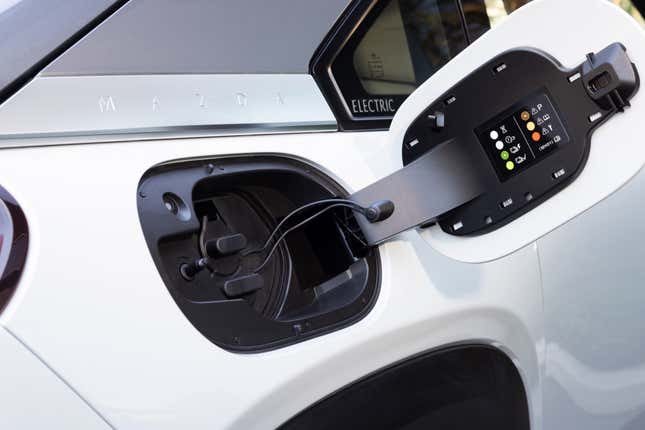Let’s get a few things out of the way to start. Mazda is only importing 560 MX-30 electric cars, and they’ll be limited to sale in California. This is not a car that Mazda sees as fitting the vast majority of American consumer lifestyles. It’s aimed largely at middle-class homeowners who already own another car and can charge at home or at work (or both) every day, most of whom do not have children. This isn’t a car for everyone, but as luck would have it, it’s a heat-seeking missile aimed directly at me. I am the target market, so how does this car fit my life?
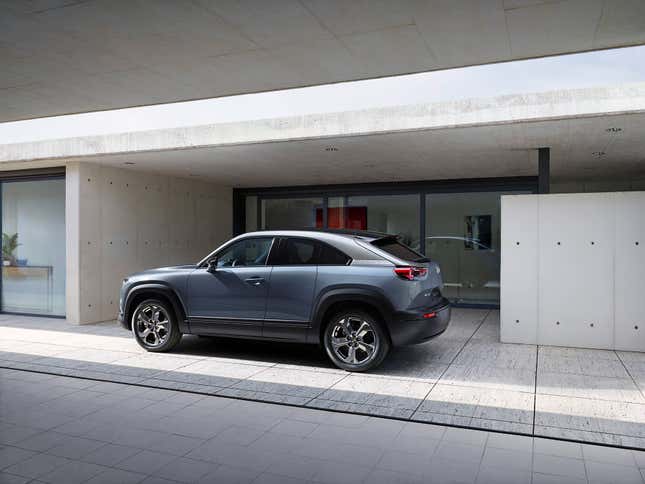
I’d be ecstatic to have this car in my driveway. I’m not generally a CUV guy, but I genuinely liked the CX-30, so making it electric is a line drive right up my alley. It’s more or less the right size for my life, a half-step smaller than a CX-5, but still big enough for hauling two adult humans and all of our stuff, plus a dog if need be.
(Full disclosure: Mazda let me borrow a loaded MX-30 in Orange County, Calif. I paid for my own travel, but Mazda did put me up in a fancy hotel and fed me fancy food.)
All cars come with tradeoffs, but EVs might have more of them than most. More range comes at the cost of weight — lots of it. A bigger battery in an EV is kind of antithetical to the whole eco-friendliness thing, too, as it makes the car a bigger resource drain, and increases the carbon emissions from initial construction of the car. Mazda was very conscious of these demands across the board. While other automakers are chasing ever longer range, Mazda wanted to make a quality EV experience with an upmarket interior and driving feel.
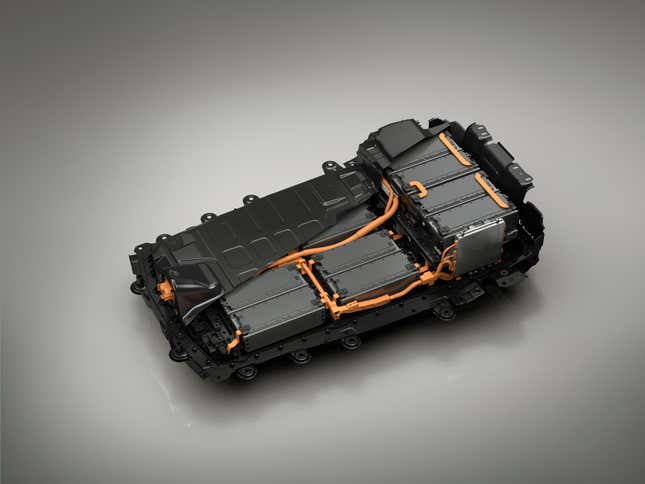
The hard truth about driving in the U.S. is that we often buy way more car than we need. MSRPs, average transaction prices, and monthly payments are ballooning at a time when more American drivers can scarcely afford the extra. As the adoption of electric tech becomes increasingly mandatory in the next decade, should we be engineering for the everyday, or the sometimes-maybe? If 100 miles of range is enough for your day-to-day life, does it make sense to haul around another 800 pounds of battery at a significant price increase for the road trip you might eventually take? When you find a fun twisty road, do you want to be weighed down? Do you want to incur the economic and environmental cost of a three times larger battery?
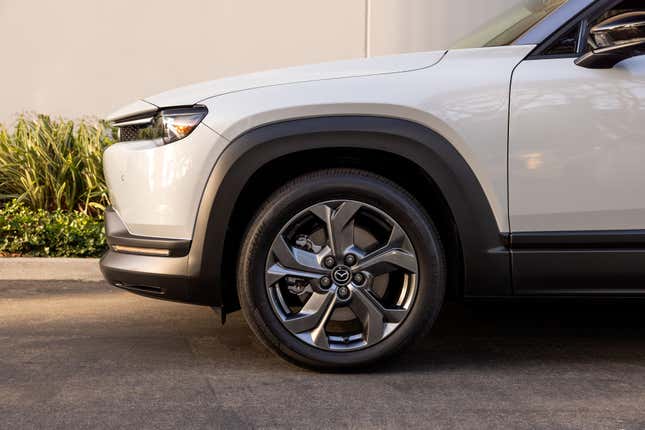
The thing to remember here is that weight is exponential. The MX-30 weighs 3,655 pounds as it sits at the curb. But if it had an extra 800 pounds of battery onboard, it would need bigger brakes, a more powerful motor, bigger wheels and tires, stronger suspension components, stronger steering components, and more safety components. That 800 pounds quickly becomes 1000 or 1200. All of a sudden you’ve got a heavy, inefficient, expensive monstrosity that is potentially less safe for other drivers and pedestrians around you.
So where do we start with Mazda’s MX-30? Our friend Ken Saito reviewed the car when it launched in Japan way back in June. I agree with most of what he said about the car, and I’m not here to re-litigate his review. I want to get down to the task of arguing on the internet!
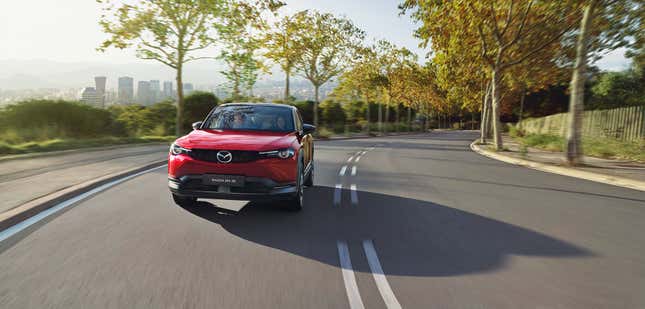
Based on what I know of automotive media, this car will be (and has been) met with cynicism. I want to take Mazda at face value and try to understand the arguments it is making before taking a shot at what the car is and who it is meant for.
The Eco-Friendly Argument
We’ll all have to make changes to our individual lifestyles in the next twenty years to accommodate electric transportation, green energy, and the regional impact of climate change. While any electric vehicle will contribute less carbon emissions to the world, the battery itself is the most carbon-intensive section of the EV production line, meaning a smaller battery isn’t as bad for the environment as a larger battery, and the “break even” mileage for a compact EV with a small battery is much smaller than a longer range EV.
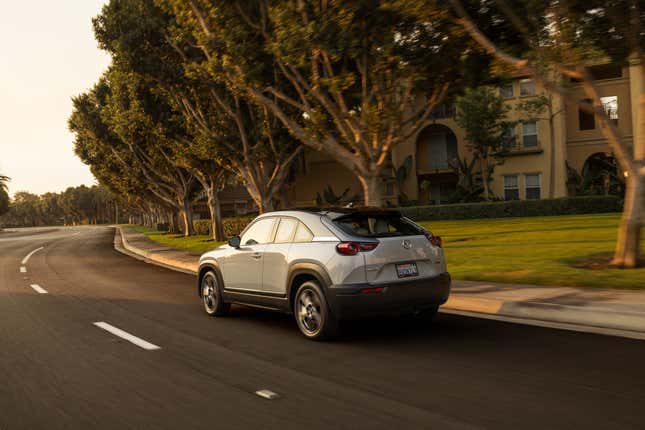
Let’s do some math based on numbers provided by this video from Engineering Explained. If we assume 150 kilograms of CO2 are created for every kilowatt hour of battery installed in your EV, then the 33.5 kWh battery in the MX-30 costs around 5,025 kg of carbon as compared to the 15,000 kg of carbon for a car with 100 kWh worth of battery. If we assume 10,000 kg of carbon for the production of the car itself, we get totals of 10,000 kg for an average ICE car, 15,025 for the MX-30, and 25,000 kg for a 100 kWh BEV.
All else being equal, and given the current electricity mix in the United States power grid, after 10 years and 135,000 miles of use, the Mazda would be responsible for 43,475 kg, the 100 kWh BEV would be responsible for about 53,450 kg, and the average ICE would be responsible for about 67,700 kg. In just 20,000 miles, or about a year and a half, the MX-30 would catch and pass a 21 mpg ICE car when it comes to CO2 emissions, while it would take about 60,000 miles for the 100 kWh BEV to do the same.

Of course this math could be totally different if Mazda is managing to produce batteries and vehicles at a better-than-average emissions rate. And if you charge on fully-renewable energy at your home like I do, your EV emissions per mile are much smaller, which would speed up the process. The point, however, stands that a smaller battery is the more eco-friendly choice.
The Dynamics Argument
If Mazda had wanted to, it probably could have just stuck the EV bits in the CX-30 and called it a day, but that’s not what happened with the MX-30. There’s new bodywork, new driving dynamics, a gorgeous new interior, and a funky return to the RX-8's “freestyle” rear-hinged doors. It’s got a modern cool hipster urban-dweller vibe to it, and somehow that works out okay.

With a 143-horsepower 200 lb.-ft electric motor sitting between the front wheels and 683 pounds of battery shifted rearward, the MX-30 has a Porsche 911-esque 40-front-60-rear weight balance. This is mostly a practical choice because it leaves the engine compartment available for the rotary range extender that Mazda confirmed is coming for the 2023 model year.
Mazda often touts its focus on Jinba Ittai, a term in Japan which refers to a “oneness between horse and rider”. The manufacturer of the much-lauded Miata has a lot of experience in this connectivity between human and machine. A lot of focus was spent developing this car’s handling, and it shows. The motor has been stiffly mounted because electric motors don’t have the NVH penalties of an internal combustion engine, and the stiffer mounting means less weight transfer under braking, acceleration, or uneven roads. The battery structure has made the car allegedly 45 percent stiffer than its CX-30 chassis mate. The tires have been made stiffer to both improve rolling resistance numbers and to reduce roll-over through the corners.
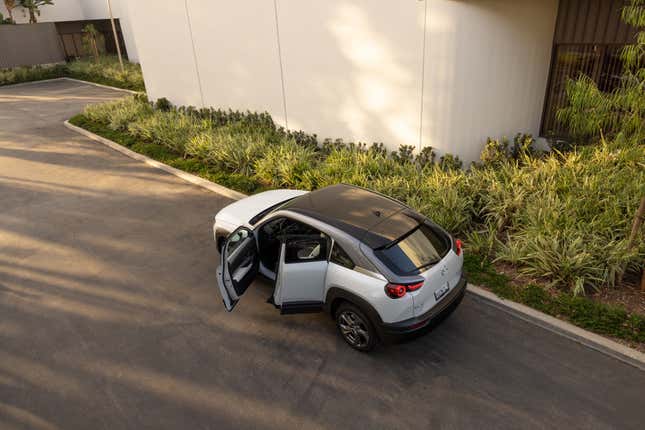
Mazda focused its efforts not on acceleration — the 0-62 time is around 9.7 seconds — but on smoothness. The reduction in jerk as you get away from a stop is incredible. The focus is on matching the driver’s intent; you can smoothly accelerate away from a stop, perhaps better than any other EV, or you can bury your foot in the accelerator and feel that grab and go indicative of electric torque. The point is to avoid a rapid change in acceleration G, giving a more comfortable feeling for most drivers.
The Interior
Okay, maybe this isn’t an argument. It’s real good, though, so it warrants its own section.
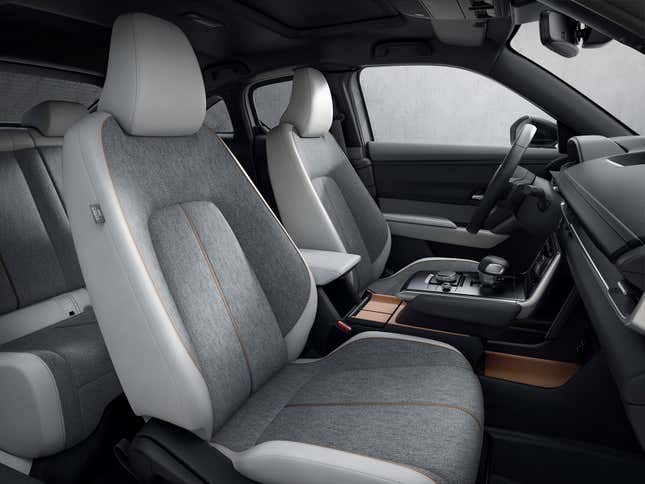
The interior of this car is perhaps its best asset. It’s beautiful and mostly comfortable, it’s well constructed, and it feels much more expensive than it is. The best argument for the MX-30 is that it’s maybe one of the best places to spend your commute or run your errands. I personally love it. The seats are good, the Mazda scroll-wheel-instead-of-touch-screen UI continues to be excellent, and the thin-rim steering wheel feels delicate but comfortable.

Slipping behind the wheel, there are plenty of things to point out. Mazda wants you to really notice that it has replaced a few of the soft-touch points with cork because it is both sustainable and part of Mazda’s heritage as it started out as a cork company back in 1920. The seat fabrics are created from partial recycled threads. The door trims are crafted from recycled plastic bottles. These are all baby steps in the right direction to get car interiors away from leathers and plastics without making them feel cheap. This is a truly nice cockpit.
At 6'2" I found one minor foible with the interior, however. With a wide driving stance, I found my knees were slightly cramped. On the right side my knee room was impacted by the “floating” center console. On the left side my knee room was impacted by the door handle (which also has cork in it). After a couple hours in the seat, I got used to it, but it remained a minor annoyance. I’m not really calling out the MX-30 on this specifically, because it’s a quite common experience for me in compact cars these days.
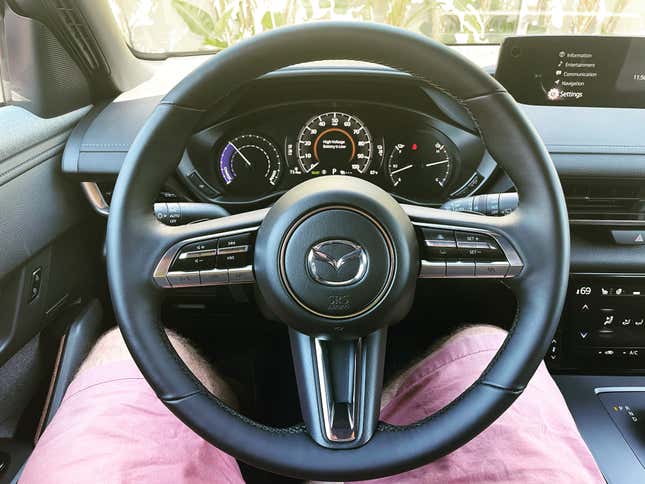
The Case For 100 Miles Of Range
Okay, so we’ve got an understanding of why Mazda says it chose to fit a smaller battery pack to the MX-30. Now let’s chew on the resulting range to determine if it’s good enough for at least some portion of American drivers to feel fits their needs.
I’ve beat this drum a lot, but as a rule, American consumers buy way too much car for their needs. That mindset isn’t limited to cars, but that’s usually where we see it most. The average commute in this country is 12.4 miles one way. Yes, that means around half of the country commutes more than that, but 50 percent of the driving population is a huge number. If you’re only driving 25 miles a day, why wouldn’t 100 miles of range work for your needs? You could plug in at work, at home — or both — and constantly be topped up.
The MX-30 starts at $33,470, and because this is Mazda’s first EV in the country, it is still eligible for all federal and California incentives. The car also comes with $500 worth of ChargePoint credits, which can be used on public ChargePoint chargers out in your travels, or you can spend it toward getting a L2 charger installed at your home.
Yes, you can get a Leaf, a Hyundai Ioniq EV, or a Kia Soul EV for about the same price as the Mazda with more range, but the interior of the Mazda is far and away the best of the bunch. It’s not really arguable that the Mazda is also the best looking, best driving, and — by dint of its non-traditional door layout — quirkiest, which are factors that we Jalops tend to value.
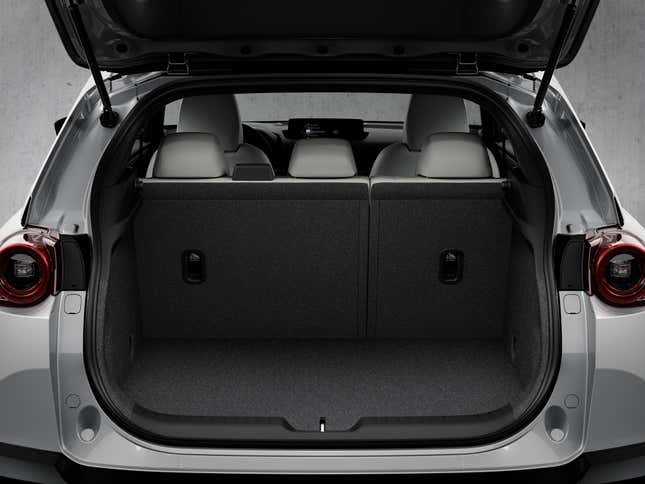
Lots of people want to compare the MX-30 to other vehicles in its price range. It’s more than that, however. I wouldn’t say this is a Leaf with fewer miles of range. Rather, this is more akin to a Volvo XC-40 Recharge with a twenty grand discount (albeit with lower range and less acceleration). It has the style and quality and driving enjoyment of the Volvo, but at a steep discount. The Nissan is a better EV, but it’s not a better car.
Yes, this car will be a difficult proposition if you only have room in your garage or budget for one car. No, this car won’t work if you need to commute 50 miles one way in a frigid climate. This is the kind of car you buy when your household consists of two working professionals with meager commutes. Both of you will need to have cars, so the one with the shorter commute would get the small-capacity EV, and the one with the longer commute either keeps their traditional ICE vehicle for now, or upgrades to a plug-in hybrid or longer range EV. Chances are, both of you won’t be replacing both of your cars at the same time, so it makes sense to upgrade the one that works for 95 percent of your driving, and keep the gas drinker for the 5 percent of the time when you need to travel out of state or take that long road trip.

It’s not an impossibility to change your driving habits to work around something like this. Most of the pushback I got when I said 100 miles of range is probably fine for most Americans on Twitter was that Americans like to take road trips for vacations. Even if this car were your only car, how often is the average American going on vacation? Once a year, usually, right? So fly somewhere, or rent a car, or holy shit take a train! If 360 days of your year can be accomplished with a relatively inexpensive, relatively eco-friendly, relatively fun to drive electric, even one with a relatively low range, why wouldn’t you?
Verdict
Ultimately, as I said at the beginning of this journey, the MX-30 EV is pretty much built for people like my wife and me. I bought an old Nissan Leaf with around 50 miles of range, and it has served extremely well as our around-town bopper and grocery getter, and before the pandemic I was using it to haul myself in to the office every morning. The MX-30 would be a much better car for those purposes, admittedly for a whole lot more money. Like 10 times more money than I paid for my janky used Leaf.

The MX-30 isn’t for everyone. Mazda thinks it’s only for 560 people, and even then only in California. I would say the market is much wider, perhaps serving the needs and functions of as much as 15 percent of American households. Getting Americans to buy something based on their needs rather than their wants, however, is going to be largely an impossibility.
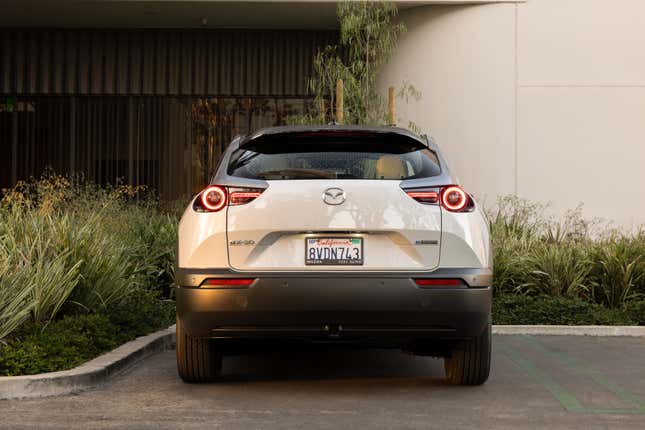
Hell, even after all that, I know the MX-30 is totally the right car for me and my life. Does that mean I want it more than a Taycan or whatever street version of the Mission R is going to be? Of course not. But would it get the job done? Absolutely.
